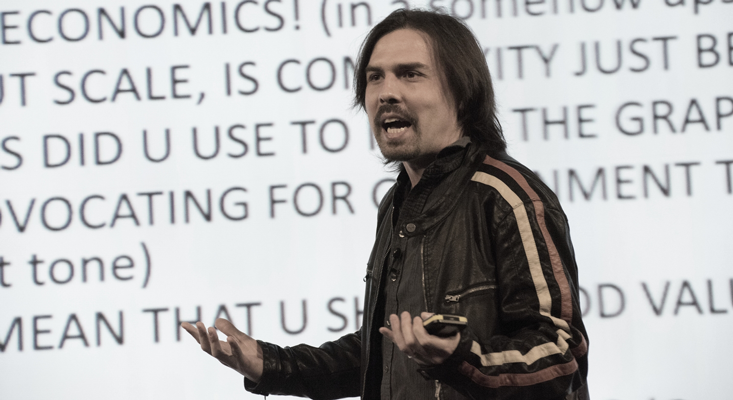A few years ago a student walked into the office of Cesar A. Hidalgo, director of the Collective Learning group at the MIT Media Lab. Hidalgo was listening to music and asked the student if she recognized the song. She wasn’t sure. “Is it Coldplay?” she asked. It was “Imagine” by John Lennon. Hidalgo took it in stride that his student didn’t recognize the song. As he explains in our interview below, he realized the song wasn’t from her generation. What struck Hidalgo, though, was the incident echoed a question that had long intrigued him, which was how music and movies and all the other things that once shone in popular culture faded like evening from public memory.
Hidalgo is among the premier data miners of the world’s collective history. With his MIT colleagues, he developed Pantheon, a dataset that ranks historical figures by popularity from 4000 B.C. to 2010. Aristotle and Plato snag the top spots. Jesus is third. It’s a highly addictive platform that allows you to search people, places, and occupations with a variety of parameters. Most famous tennis player of all time? That’s right, Frenchman Rene Lacoste, born in 1904. (Roger Federer places 20th.) Rankings are drawn from, essentially, Wikipedia biographies, notably ones in more than 25 different languages, and Wikipedia page views.

Last month Hidalgo and colleagues published a Nature paper that put his crafty data-mining talents to work on another question: How do people and products drift out of the cultural picture? They traced the fade-out of songs, movies, sports stars, patents, and scientific publications. They drew on data from sources such as Billboard, Spotify, IMDB, Wikipedia, the U.S. Patent and Trademark Office, and the American Physical Society, which has gathered information on physics articles from 1896 to 2016. Hidalgo’s team then designed mathematical models to calculate the rate of decline of the songs, people, and scientific papers.
The report, “The universal decay of collective memory and attention,” concludes that people and things are kept alive through “oral communication” from about five to 30 years. They then pass into written and online records, where they experience a slower, longer decline. The paper argues that people and things that make the rounds at the water cooler have a higher probability of settling into physical records. “Changes in communication technologies, such as the rise of the printing press, radio and television,” it says, affect our degree of attention, and all of our cultural products, from songs to scientific papers, “follow a universal decay function.”
Last week I caught up with Hidalgo to talk about his Nature paper. But I also wanted to push him to talk about what he saw between the mathematical lines, to wear the social scientist’s hat and reflect on the consequences of decay in collective memory.
How do you define “collective memory?”
The easiest definition would be those pieces of knowledge or information that are shared by a large number of people.
Why does collective memory decay matter?
If you think about it, culture and memory are the only things we have. We treasure cultural memory because we use that knowledge to build and produce everything we have around us. That knowledge is going to help us build the future and solve the problems we have yet to solve. If aliens come here and wave a magic wand and make everyone forget everything—our cars, buildings, bridges, airplanes, our power systems, and so forth, we would collapse as a society immediately.
The relative power of scientists has diminished as we exited the printing era and went into this more performance-based era.
In your mind, what is a classic example of collective memory decay?
I thought everybody knew “Imagine” by John Lennon. I’m almost 40 and my student was probably 20. But I realized “Imagine” is not as popular in her generation as it was in mine, and it was probably less popular in my generation than in the generation before. People have a finite capacity to remember things. There’s great competition for the content out there, and the number of people who know or remember something decays over time. There’s another example, of Elvis Presley memorabilia. People had bought Elvis memorabilia for years and it was collecting huge prices. Then all of a sudden the prices started to collapse. What happened is the people who collected Elvis memorabilia started to die. Their families were stuck with all of this Elvis stuff and trying to sell it. But all of the people who were buyers were also dying.
You write collective memory also reflects changes in communication technologies, such as the rise of the printing press, radio, and TV. How so?
Take print. Changing the world from an oral tradition to a written tradition provided a much better medium for data. A lot of people have linked the revolution in the sciences and astronomy to the rise of printing because astronomical tables, for instance, could be copied in a reliable way. Before printing, astronomical tables were hand-copied, which introduced errors that diminished the quality of the data. With printing, people had more reliable forms of data. We see very clearly from our data that with the rise of printing you get the rise of astronomers, mathematicians, and scientists. You also see a rise in composers because printing helps the transmission of sheet music. So when you look at people we remember most from the time when print first arose, you see ones from the arts and sciences.
What did the mediums that came next mean for science?
The new mediums of radio and TV were much more adaptive for entertainment than science, that’s for sure. The people who belong to the sciences, as a fraction of the people who became famous, diminished enormously during the 20th century. The new mediums were not good for the nuances that science demands. For good reason, scientists need to qualify their statements narrowly and be careful when they talk about causality. They need to be specific about the methods they use and the data they collect. All of those extensive nuances are hard to communicate in mediums that are good for entertainment and good for performance. So the relative power of scientists, or their position in society, have diminished as we exited the printing era and went into this more performance-based era.
At the same time, scientists and the general scientific community have not been great at adapting their ideas to new mediums. Scientists are the first ones to bring down another scientist who tries to popularize content in a way that would not be traditional. So scientists are their own worst enemies in this battle. They have lagged behind in their ability to learn how to use these mediums. Sometimes they focus too much on the content without paying attention on how to adapt it to the medium that will best help it get out.
What does your analysis tell us we didn’t know before about the decay of collective memory?
We began by looking at how popular something is today based on how long ago it became popular in the first place. The expectation is collective memory decays over time in a smooth pattern, that the more time goes by, the more things become forgotten. But what we found when we looked at cultural products—movies, songs, sports figures, patents, and science papers—was that decay is not smooth, but has two defined regimes. There’s the first regime in which the attention starts very high and the decay is really fast. Then there’s the second regime in which it has a much longer tail, when the decay is smoother, and the attention is less.
I’m surprised how the U.S., a country with people doing so many things, can become so monothematic on such a vast scale.
When we started to think about decay, we realized we could take two concepts from anthropology—“communicative memory” and “cultural memory.” Communicative memory arises from talking about things. Donald Trump is very much in our communicative memory now. You walk down the street and find people talking about Trump—Trump and tariffs, Trump and the trade war. But there’s going to be a point, 20 years in the future, in which he’s not going to be talked about everyday. He’s going to exit from communicative memory and be part of cultural memory. And that’s the memory we sustain through records. Although the average amount of years that something remains in communicative memory varies—athletes last longer than songs, movies, and science papers, sometimes for a couple decades—we found this same overall decay pattern in multiple cultural domains.
In your forthcoming paper, “How the medium shapes the message,” you refer to the late cultural critic Neil Postman who argued that the popular rise of TV led to a new reign of entertainment, which dumbed us down, because entertainment was best suited for TV. Is that what you found?
We found evidence in that favor, yes. Because the fraction of people who belong to the sciences, as a fraction of all of the people that become famous, diminishes enormously during the 20th century. It would completely agree with that observation.
Do you agree with Postman that we’re all “amusing ourselves to death?”
I don’t think we’re amusing ourselves to death. I’m not like that much of a pessimist. I do think life is also about enjoying the ride, not just about doing important things. And new mediums like TikTok, a kind of Twitter for videos, are great for creative expression. People are doing amazing little performance skits on TikTok. The entertainment and artistic components of every new medium are not bad per se, but every medium can be hijacked by extreme people who know how to craft entertaining messages, especially when they want to advance a certain agenda.
What type of information is best suited for the Internet?
It’s hard to think of the Internet as a medium. It’s more of a platform in which Facebook, Twitter, email, and TikTok are different mediums. They each send their own type of message. A picture that does well on Instagram doesn’t necessarily shine on Twitter, where people are expecting something else. The behavior and the engagements are different. Twitter, for example, is about being controversial. You know, one way to get chewed up on Twitter is to try to be in the center! I use Twitter a little, but not that much. I find that it’s a little bit hostile. I’m a family type of guy, so I use Facebook. In Facebook, at least in my circle, you put more detail into comments and are a little bit more thoughtful.
Now people like Elon Musk are in the center of culture. Young people now look up to entrepreneurs the way we used to look up to musicians.
Is collective memory decaying more rapidly because communication technologies are so much faster?
I would love to know that but I can’t. Some people would say collective memory decays based not on calendar time but the speed at which new content is being produced. We forget Elvis because the Beatles came up and we forget the Beatles because Led Zeppelin came and we forget Led Zeppelin because Metallica came up, and so forth. But things become very dear to a generation and people will not forget about them just because new content came in. So decay would be something characteristic of humans, not the volume of content. To separate those two things, we would need to look at content from very different time frames. At the moment, we don’t have the richness of data that we would need to answer that question.
Still, don’t you think the speed at which online information is tearing through our brains has got to be leaving some path of destruction in collective memory?
I don’t know. I grew up in Chile, which of course is small compared to the United States. I came to the U.S. for the first time in 1996. And one of the things that still surprises me is how monothematic American culture can be. In 1996 it was all about O.J. Simpson. Everybody talked about O.J. Simpson. He was everywhere on TV. Just like Trump today, he consumed the entire bandwidth. I’m surprised how a country with so many people, and with people doing so many different things, can nevertheless become so monothematic on such a vast scale. Today we have so much more content than in 1996 because of the rise of the Internet and the ability of people to create content. But look at the percentage of all conversations and online communications that are consumed by Trump. So in that context, I don’t think content is being replaced so easily. I don’t see that much of a rise in diversity.
That’s really interesting. Because one of the common criticisms of the current information glut is we have no shared cultural center. Everybody has their own narrow interest and we have no shared cultural bond, no John Lennon.
Is that a collective memory phenomena or is it because nowadays the guys in the middle of the culture are different guys? Different people come into the center of culture because of the type of mediums that are available. There have been musicians for thousands of years, and for most of that history, musicians have not been wealthy. It was only when there was a medium that allowed them to sell their music—vinyl, magnetic tapes, and discs—that they were able to make money. I think that generated a golden era of pop music in the ’60s, ’70s, and ’80s. And that’s associative to a communication technology that was dominant at that time. Radio and discs were a way to distribute those popular idols’ musical performances. When that technology was replaced by simple forms of copying, like the ability to copy files on the Internet, all that went away. Now people like Elon Musk are in the center of culture. He’s not John Lennon. It’s a very different type of leadership, a different type of model for young people. But Musk’s first job was an online payment start-up. And I think a lot of young people now look up to entrepreneurs the way we used to look up to musicians.
Did you come away from your study with insights into what may or may not cause something to stick in collective memory?
I read a very good book recently called The Formula by Albert-Laszlo Barabas. He says you can equate quality and popularity in situations in which performance is clearly measurable. But in cases in which performance is not clearly measurable, you cannot equate popularity with quality. If you look at tennis players, you find tennis players who win tournaments and difficult games are more popular. So quality and fame are closely correlated in a field in which performance is measured as tightly as professional tennis players. As you move to things that are less quantifiable in terms of performance, like modern art, your networks are going to be more important in determining popularity.
How should we think about quality in media content?
Well, I would say that collective memory decay is an important way to measure and think about quality. If you publish some clickbait that is popular in the beginning, that gets a lot of views in the first couple of days, but a year later, nobody looks at it, you have a good metric. The same is true if you publish a more thoughtful piece that might not be as popular in the beginning because it didn’t work as clickbait—it required more engagement from the readers—but keeps on building readers over time. So the differences in longevity are important metrics for quality.
That goes back to a paper I did when I was an undergrad about the decay functions of attendance of movies. There were some movies that had a lot of box office revenue in the first week but then decayed really fast. And there were other movies that decayed more slowly. We created a model in which people would talk to each other and communicate information of the quality of the movie. And that model only had one parameter, which was how good was the movie was. So the quality of the movie would increase or decrease the probability that people would go watch it. We could then look at the curves and infer how good the movie was, based not on the total area it was shown, or on the total revenue, but on the shape of the curve. That was interesting because there were movies that were really bad like Tomb Raider, which at first was a box office success. But if you put it on our model, you would see that it was just hype, people watched it, hated the movie, and the curve decayed really fast.
Kevin Berger is Nautilus’ features editor.


























